warning OLDSMOBILE SILHOUETTE 1998 Owners Manual
[x] Cancel search | Manufacturer: OLDSMOBILE, Model Year: 1998, Model line: SILHOUETTE, Model: OLDSMOBILE SILHOUETTE 1998Pages: 444, PDF Size: 23.2 MB
Page 9 of 444

How to Use this Manual
Many people read their owner’s manual from beginning
to end when they first receive their
new vehicle. If you
do this, it will help
you learn about the features and
controls for your vehicle. In this manual, you’ll find
that pictures and words work together to explain
things quickly.
Index
A good place to look for what you need is the Index in
back
of the manual. It’s an alphabetical list of what’s in
the manual, and the page number where you’ll find it.
Safety Warnings and Symbols
You will find a number of safety cautions in this book.
We use a box and the word CAUTION to tell you
about things that could hurt you if you were to ignore
the warning.
e I
These mean there is something that could hurt
you or other people.
In the caution area, we tell you what the hazard is. Then
we tell you what to do to help avoid or reduce the
hazard. Please read these cautions.
If you don’t, you or
others could be hurt.
You will also find a circle
with a slash through it in
this
book. This safety
symbol means “Don’t,”
“Don’t
do this” or “Don’t
let this happen.’’
iii
ProCarManuals.com
Page 10 of 444
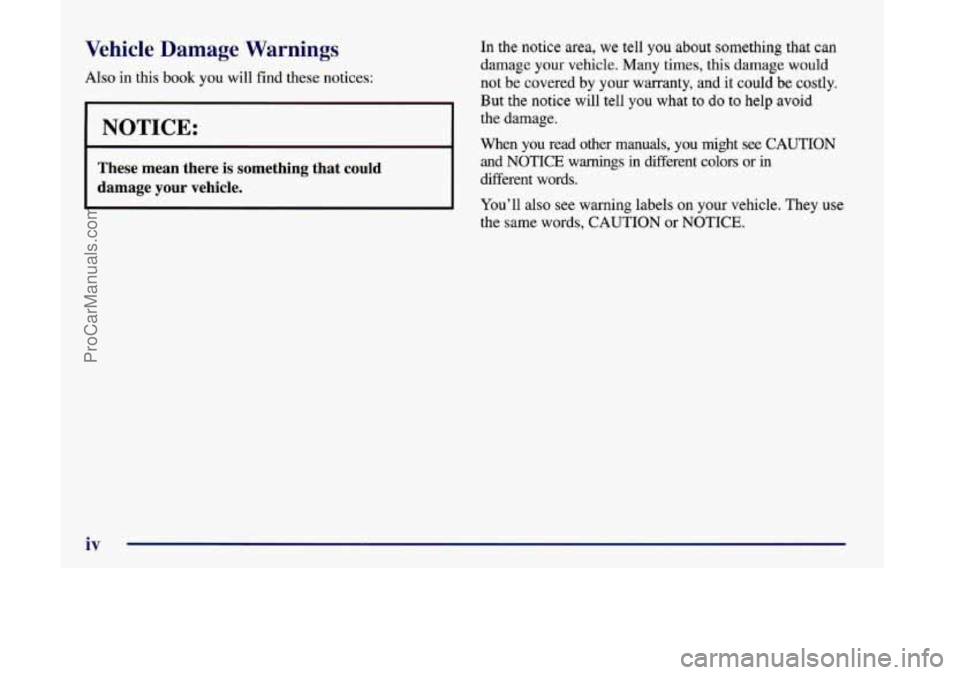
Vehicle Damage Warnings
Also in this book you will find these notices:
I NOTICE:
These mean there is something that could
damage your vehicle.
iv
In the notice area, we tell you about something that can
damage
your vehicle. Many times, this damage would
not
be covered by your warranty, and it could be costly.
But the notice will tell you what
to do to help avoid
the damage.
When you read other manuals, you
mgnr see CAUTION
and
NOTICE warnings in different colors or in
different words.
You’ll also see warning labels
on your vehicle. They use
the same words, CAUTION or NOTICE.
ProCarManuals.com
Page 11 of 444
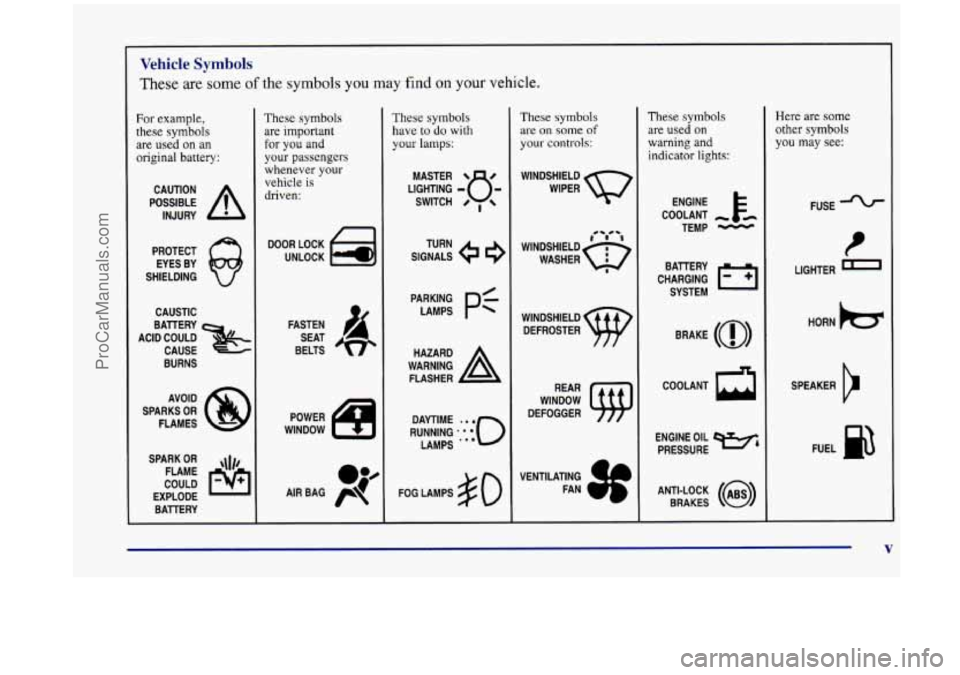
Vehicle Symbols
These are some of the symbols you may find on your vehicle.
For example,
these symbols are used on an
original battery:
POSSIBLE A
CAUTION
INJURY
PROTECT EYES BY
SHIELDING
CAUSTIC
ACID COULD BAllERY
CAUSE
BURNS
AVOID
SPARKS
OR
FLAMES
SPARK
OR ,\I/,
COULD FLAME
EXPLODE BAllERY
These symbols
are important
for you and
your passengers
whenever
your
vehicle is
driven:
DOOR LOCK
UNLOCK
FASTEN SEAT
BELTS
These symbols
have to do with
your lamps:
SIGNALS e
TURN
WARNING
A
HAZARD
FLASHER
FOG LAMPS
$0
These symbols
are on some of
your controls:
WINDSHIELD
WIPER
WINDSHIELD DEFROSTER
WINDOW
DEFOGGER
These symbols
are used on
warning and indicator lights:
ENGINE E*
COOLANT
TEMP
-
CHARGING I-1
BATTERY
SYSTEM
BRAKE
(a)
COOLANT a
ENGINE OIL e,
PRESSURE
ANTI-LOCK
(@)
BRAKES
Here are some other symbols you may see:
FUSE
LIGHTER
m
HORN )cr
SPEAKER
b
FUEL e3
ProCarManuals.com
Page 75 of 444

Using the vehicle’s regular safety belts on a child
seated on the child restraint cushion can cause
serious injury to the child in a sudden stop or
crash.
If a child is the proper size for the built-in
child restraint, secure the child using the child
restraint’s harness. But children who are too
large for the built-in child restraint should sit on
the vehicle’s regular seat and use the vehicle’s
adult safety belts.
WARNING! FAILURE TO FOLLOW THE
MANUFACTURER’S INSTRUCTIONS ON THE
USE
OF THIS CHILD RESTRAINT SYSTEM
CAN RESULT IN YOUR CHILD STRIKING THE
VEHICLE’S INTERIOR DURING A SUDDEN
STOP OR CRASH. SNUGLY ADJUST THE
BELTS PROVIDED WITH THIS CHILD
RESTRAINT
AROUND YOUR CHILD.
4. Before placing the child in the child restraint, add
slack to the shoulder harness. Pull the black shoulder
harness release strap
firmly. At the same time pull
both shoulder harness straps through the slots in the
seatback as shown.
5. Place the child on the child restraint cushion.
1-63
ProCarManuals.com
Page 103 of 444
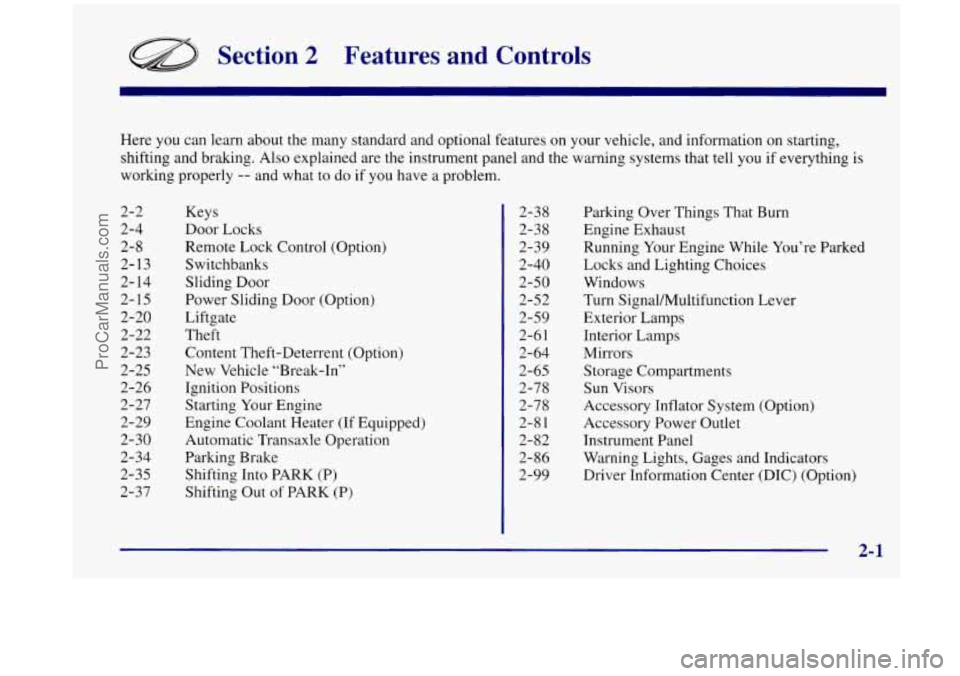
Section 2 Features and Controls
Here you can learn about the many standard and optional features on your vehicle, and information on starting,
shifting and braking. Also explained are the instrument panel and the warning systems that tell you if everything is
working properly
-- and what to do if you have a problem.
2-2
2-4
2-8
2-13
2-
14
2-15
2-20
2-22
2-23
2-25
2-26
2-27
2-29
2-30
2-34 2-35
2-37 Keys
Door Locks
Remote Lock Control (Option)
Switchbanks
Sliding Door
Power Sliding Door (Option)
Liftgate
Theft
Content Theft-Deterrent (Option)
New Vehicle “Break-In”
Ignition Positions
Starting Your Engine
Engine Coolant Heater
(If Equipped)
Automatic Transaxle Operation
Parking Brake
Shifting Into PARK
(P)
Shifting Out of PARK (P)
2-38
2-38
2-39
2-40
2-50
2-52
2-59
2-6
1
2-64
2-65
2-78
2-78
2-8
1
2-82
2-86 2-99 Parking Over Things
That Burn
Engine Exhaust
Running Your Engine While You’re Parked
Locks and Lighting Choices
Windows
Turn SignalMultifunction Lever
Exterior Lamps
Interior Lamps
Mirrors Storage Compartments
Sun Visors
Accessory Inflator System (Option)
Accessory Power Outlet
Instrument Panel
Warning Lights, Gages and Indicators
Driver Information Center (DIC) (Option)
2-1
ProCarManuals.com
Page 118 of 444
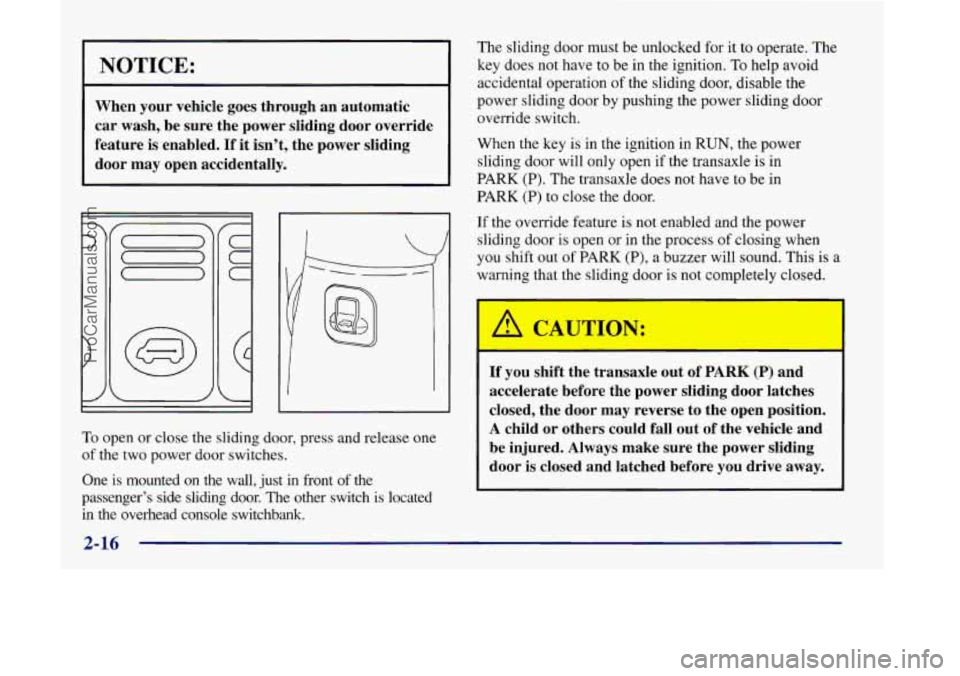
NOTICE:
When your vehicle goes through an automatic
car wash, be sure the power sliding door override
feature is enabled.
If it isn’t, the power sliding
door
may open accidentally.
7
C
C
C
The sliding door must be unlocked for it to operate. The
key does not have to be in the ignition. To help avoid
accidental operation of the sliding door, disable the
power sliding door by pushing the power sliding door
override switch.
When the key is in the ignition in RUN, the power
sliding door will only open if the transaxle
is in
PARK (P). The transaxle does not have to be in
PARK (P) to close the door.
If the override feature is not enabled and the power
sliding door is open or in the process of closing when
you shift out of PARK (P), a buzzer will sound. This is a
warning that the sliding door is not completely closed.
To open or close the sliding door, press and release one
of the two power door switches.
One
is mounted on the wall, just in front of the
passenger’s side sliding door. The other switch
is located
in the overhead console switchbank.
If you shift the transaxle out of PARK (P) and
accelerate before the power sliding door latches
closed, the door may reverse to the open position.
A child or others could fall out of the vehicle and
be injured. Always make sure the power sliding
door
is closed and latched before you drive away.
2-16
ProCarManuals.com
Page 123 of 444
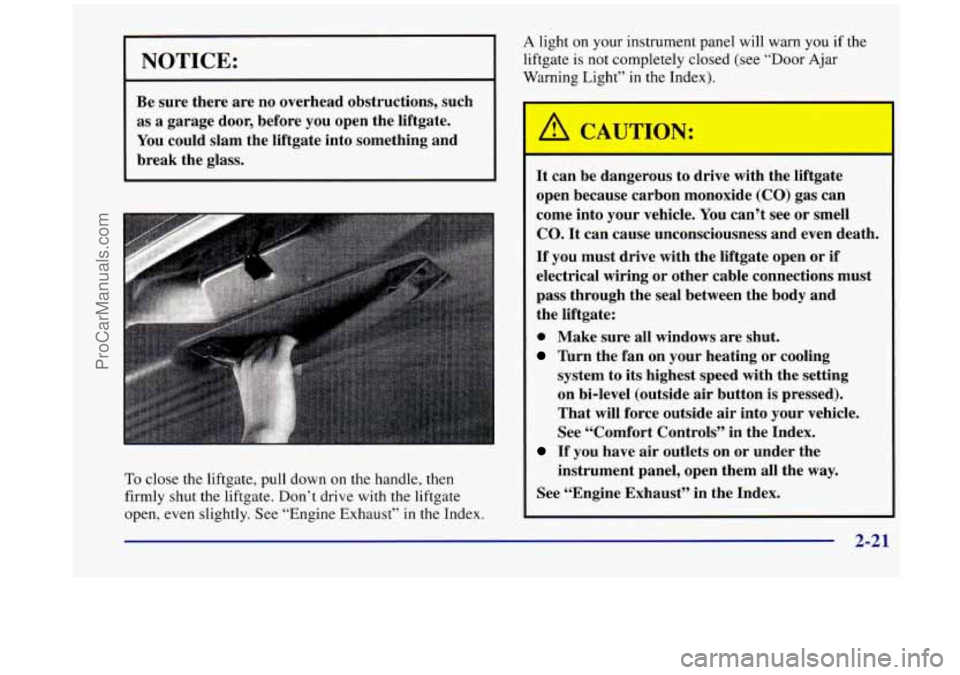
NOTICE:
Be sure there are no overhead obstructions, such
as a garage door, before you open the liftgate.
You could slam the liftgate into something and
break the glass.
To close the liftgate, pull down on the handle, then
firmly shut the liftgate. Don’t drive with the liftgate
open, even slightly. See “Engine Exhaust”
in the Index.
A light on your instrument panel will warn you if the
liftgate
is not completely closed (see “Door Ajar
Warning Light” in the Index).
It can be dangerous to drive with the liftgate open because carbon monoxide
(CO) gas can
come into your vehicle. You can’t see or smell
CO. It can cause unconsciousness and even death.
If you must drive with the liftgate open or if
electrical wiring or other cable connections must
pass through the seal between the body and
the liftgate:
0 Make sure all windows are shut.
Turn the fan on your heating or cooling
system to its highest speed
with the setting
on bi-level (outside air button is pressed).
That will force outside air into your vehicle.
See “Comfort Controls” in the Index.
If you have air outlets on or under the
instrument panel, open them all the
way.
See ‘(Engine Exhaust” in the Index.
2-21
ProCarManuals.com
Page 128 of 444
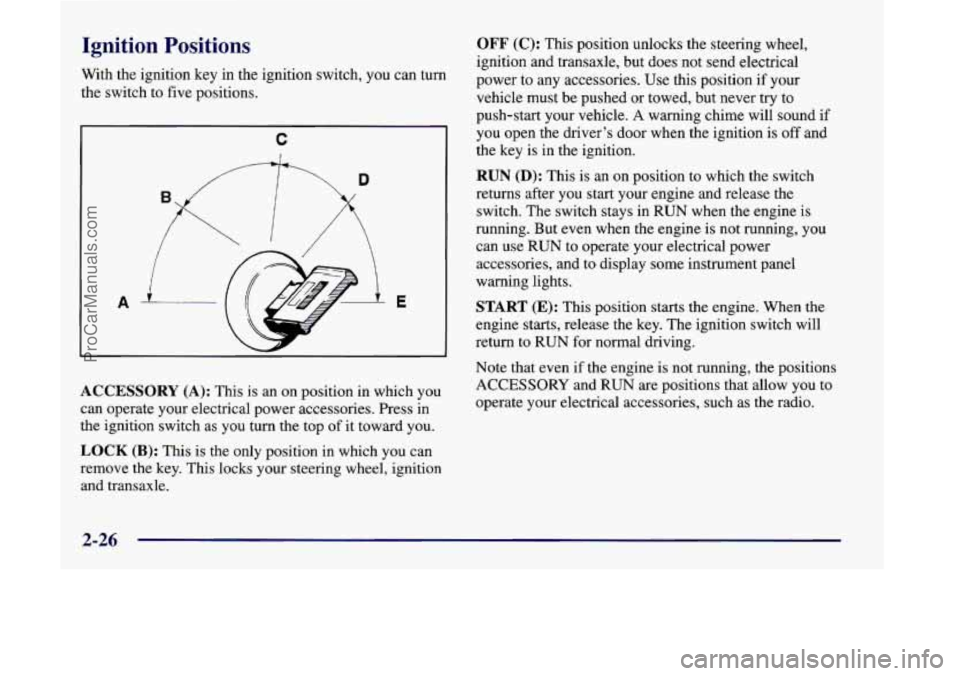
Ignition Positions
With the ignition key in the ignition switch, you can turn
the switch to five positions.
C
ACCESSORY (A): This is an on position in which you
can operate your electrical power accessories. Press in
the ignition switch as you turn the top
of it toward you.
LOCK (B): This is the only position in which you can
remove the key. This locks your steering wheel, ignition
and transaxle.
OFF (C): This position unlocks the steering wheel,
ignition and transaxle, but does not send electrical
power to any accessories. Use this position if your
vehicle must be pushed or towed, but never try to
push-start your vehicle.
A warning chime will sound if
you open the driver’s door when the ignition is off and
the key is in the ignition.
RUN (D): This is an on position to which the switch
returns after you start your engine and release the
switch.
The switch stays in RUN when the engine is
running. But
even when the engine is not running, you
can use RUN to operate your electrical power
accessories, and to display some instrument panel
warning lights.
START (E): This position starts the engine. When the
engine starts, release the key. The ignition switch will
return to RUN for normal driving.
Note that even
if the engine is not running, the positions
ACCESSORY and RUN are positions that allow you to
operate your electrical accessories, such as the radio.
2-26
ProCarManuals.com
Page 136 of 444
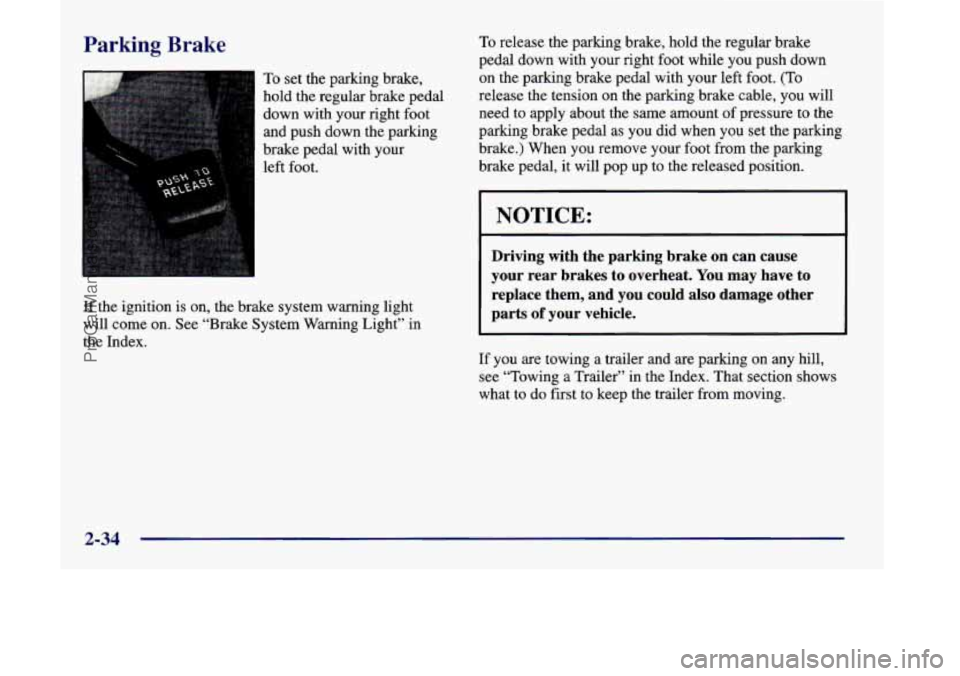
Parking Brake
To set the parking brake,
hold the regular brake pedal
down with your right foot
and push down the parking
brake pedal with your
left foot.
If the ignition is on, the brake system warning light
will come on. See “Brake System Warning Light” in
the Index.
To release the parking brake, hold the regular brake
pedal down with your right foot while you push down
on the parking brake pedal with your left foot.
(To
release the tension on the parking brake cable, you will
need to apply about the same amount of pressure to the
parking brake pedal as you did when you set the parking
brake.) When you remove your foot from the parking
brake pedal,
it will pop up to the released position.
NOTICE:
Driving with the parking brake on can cause
your rear brakes to overheat. You may have to
replace them, and you could also damage other
parts
of your vehicle.
If you are towing a trailer and are parking on any hill,
see “Towing a Trailer” in the Index. That section shows
what to do first to keep the trailer from moving.
2-34
ProCarManuals.com
Page 161 of 444
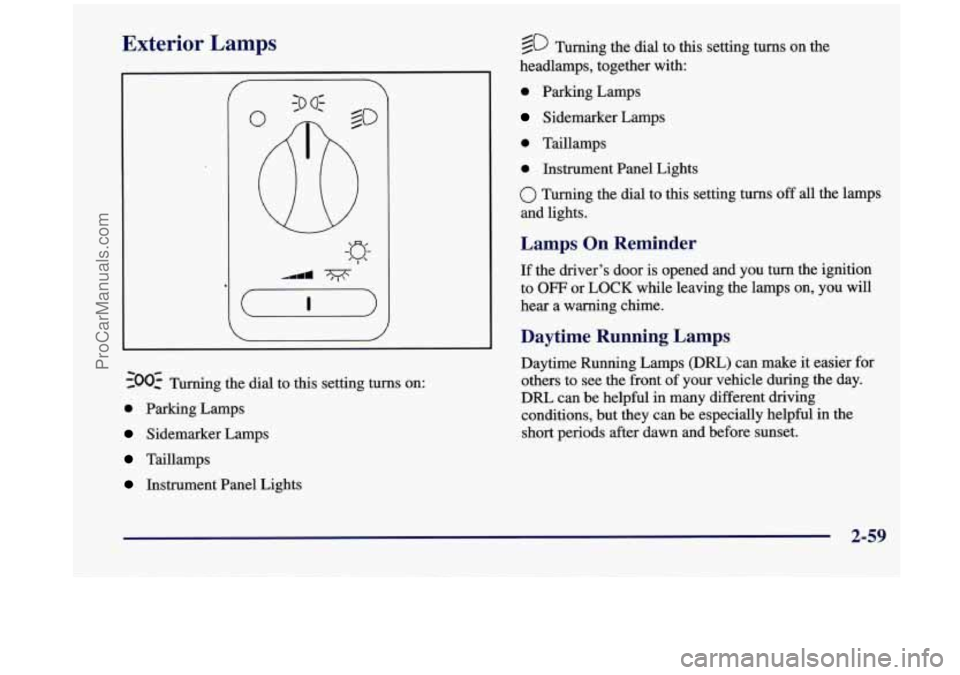
Exterior Lamps
500: Turning the dial to this setting turns on:
0 Parking Lamps
Sidemarker Lamps
Taillamps
Instrument Panel Lights
@ Turning the dial to this setting turns on the
headlamps, together with:
. Parking Lmps
Sidemarker Lamps
0 Taillamps
0 Instrument Panel Lights
0 Turning the dial to this setting turns off all the lamps
and lights.
Lamps On Reminder
If the driver’s door is opened and you turn the ignition
to
OFF or LOCK while leaving the lamps on, you will
hear a warning chime.
Daytime Running Lamps
Daytime Running Lamps (DRL) can make it easier for
others to see the front
of your vehicle during the day.
DlU can be helpful
in many different driving
conditions, but they can be especially helpful in the
short periods after dawn and before sunset.
2-59
ProCarManuals.com